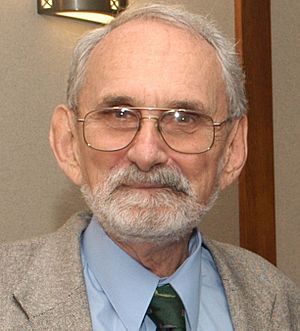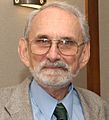Robert Curl facts for kids
Quick facts for kids
Robert Curl
|
|
|---|---|
| Robert Floyd Curl Jr. | |

Curl in 2009
|
|
| Born | August 23, 1933 Alice, Texas, U.S.
|
| Died | July 3, 2022 (aged 88) Houston, Texas, U.S.
|
| Alma mater | Rice Institute, BS; University of California, Berkeley, PhD |
| Known for | The discovery of fullerenes |
| Awards | Nobel Prize in Chemistry in 1996. Cross-cultural ambassador at Sorbonne University UNESCO Club |
| Scientific career | |
| Fields | Chemistry |
| Institutions | Rice University, Harvard University |
| Thesis | Some spectroscopic and thermodynamic properties of molecules (1957) |
| Doctoral advisor | Kenneth Pitzer |
| Doctoral students | Lihong V. Wang James L. Kinsey |
Robert Floyd Curl Jr. (born August 23, 1933 – died July 3, 2022) was an American chemist. He was a professor of chemistry at Rice University. In 1996, he won the Nobel Prize in Chemistry. He shared the prize with Richard Smalley and Harold Kroto. They won for discovering a special material called buckminsterfullerene. This discovery led to a whole new group of materials called fullerenes.
Contents
Early Life and School
Robert Curl was born in Alice, Texas, in the United States. His father was a Methodist minister, so his family moved around a lot in Texas.
Curl became interested in chemistry when he was nine years old. He got a chemistry set as a gift. He once accidentally spilled nitric acid on his mother's stove, which ruined the finish! He went to Thomas Jefferson High School in San Antonio, Texas. His chemistry teacher gave him special projects to work on in his final year.
He earned his first degree, a Bachelor of Science, from Rice Institute in 1954. He liked Rice because of its strong academics and football team. Plus, it didn't charge tuition back then. He then got his advanced degree (a doctorate) in chemistry in 1957. He studied at the University of California, Berkeley. There, he worked with Kenneth Pitzer, who became a lifelong friend and colleague.
Scientific Work
After Berkeley, Curl worked at Harvard University. He used special tools to study how molecules move. In 1958, he joined the faculty at Rice University. He took over the lab and students of another professor who was leaving.
Curl's early research looked at how molecules like chlorine dioxide behave. He studied tiny particles called free radicals. He used microwave spectroscopy and lasers to find and study them. This helped him understand their structure and how they react.
The Nobel Prize Discovery
At Rice, Curl continued his research using special light techniques. In 1976, another scientist named Richard Smalley came to Rice. Smalley wanted to work with Curl.
In 1985, a scientist named Harold Kroto contacted Curl. Kroto wanted to use a laser machine built by Smalley. He wanted to study how long chains of carbon atoms form in space, like in red giant stars. Smalley and Curl were busy studying other materials like semiconductors. But they eventually agreed to help Kroto.
They found the long carbon chains they were looking for. But they also found something unexpected! It was a new molecule with 60 carbon atoms. For 11 days, the team studied this new molecule. They figured out its structure and named it buckminsterfullerene. They named it after Buckminster Fuller, an architect known for his geodesic domes. The new molecule looked just like a tiny dome.
This discovery was based on a single measurement from a machine called a mass spectrograph. It showed a substance that was very stable and had no loose ends. Curl helped find the best conditions for the carbon vapor in the machine. He also carefully checked the measurements. Curl believed that two other team members, James R. Heath and Sean C. O'Brien, also deserved a lot of credit.
Scientists had thought about this type of molecule before, but Curl and his team didn't know that at the time. Later experiments proved their idea about the molecule's structure. The team then made other similar molecules called endohedral fullerenes. These had a metal atom inside the hollow carbon shell.
The fullerenes, which buckminsterfullerene was the first of, are now very important. They are used in nanomaterials and tiny electronics. In 2015, their 1985 paper about C60 was honored with an award. The discovery of fullerenes was also recognized as a National Historic Chemical Landmark in 2010.
After winning the Nobel Prize in 1996, Curl stayed humble. He didn't become a big public speaker like some other Nobel winners. He said he enjoyed his work and wanted to keep doing it. When the President of Rice University asked him what he wanted after the Nobel announcement, Curl simply asked for a bike rack closer to his office!
Later Research and Retirement
In his later years, Curl worked on physical chemistry. He helped develop tools for studying DNA. He also created special sensors to detect tiny amounts of gases using lasers. At Rice University, he was known for being the first master of Lovett College, a student residence.
Curl retired in 2008 when he was 74 years old. He became a professor emeritus, which means he was still honored by the university after retiring.
Personal Life
Robert Curl married Jonel Whipple in 1955. They had two children. He liked to cycle to his office and lab. Every week, he played bridge with a group called the Rice Bridge Brigade. Robert Curl passed away in Houston on July 3, 2022, at the age of 88.
Awards and Honors
- Clayton Prize, Institute of Mechanical Engineers, 1957
- Alexander von Humboldt Senior US Scientist Award, University of Bonn, Germany, 1984
- Fellow of the National Academy of Sciences, 1997
- Golden Plate Award of the American Academy of Achievement, 1997
- Fellow of the American Academy of Arts and Sciences, 1998
- International Prize for New Materials, American Physical Society, 1992
- Nobel Prize in Chemistry, Royal Swedish Academy of Sciences, 1996
- Johannes Marcus Marci Award in Spectroscopy, 1998
- Centenary Medal, Royal Society of Chemistry, 1999
- Honorary Fellow, The Royal Society of New Zealand, 2001
- University of Bochum Research Prize, 2004
- National Historic Chemical Landmark, American Chemical Society, 2010
- Citation for Chemical Breakthrough Award, Division of History of Chemistry, American Chemical Society, 2015
- Fellow of the Optical Society of America
Images for kids
See also
 In Spanish: Robert F. Curl para niños
In Spanish: Robert F. Curl para niños


